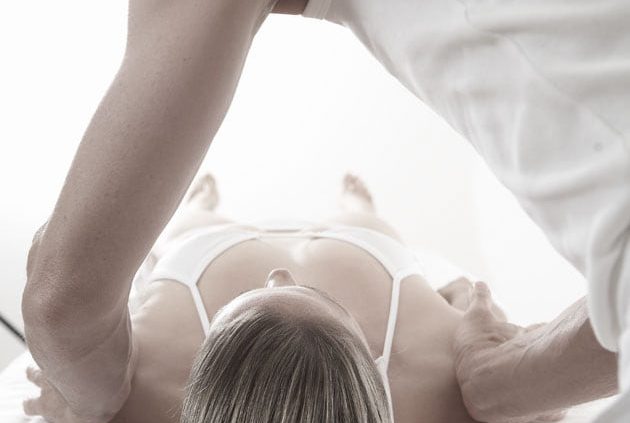The recipe – the 10 series in Rolfing
I often receive clients with severe complaints. Here the respective topic is so much in the foreground that I do not work after the 10 series. In such cases it is important to help the body to quickly reduce the pain symptoms to a tolerable level.
Some clients come to me to get the Rolfing® 10 series. They know that this is a process in which they are entering. They usually have rather minor physical complaints which we can integrate into the process of the 10 series.
„You’ll hear a lot of the word ,Recipe‘ flung around here, meaning that there is a route, there is a map by which you approach this, but I will not be happy if that’s all you know about what you’re doing!“
Dr. Ida P. Rolf (1)
The Rolfing 10 series was conceived by Dr. Ida Rolf when, after 30 years of practical experience, she began to pass on her method to students. Each treatment has a special focus and the whole series follows an inner logic. In the course of the ten sessions, the shortenings in the fascial system are worked on step by step and you learn to deal with the newly gained inner and outer freedom of movement.
Dr. Ida Rolf taught the concept of the 10-series to her students, but when she gave a session herself, she rarely stuck to it. The concept is therefore not worthless, but shows that it is more important to recognize what a body needs than to encounter it with a ready-made concept. The concept also shows that it takes at least ten sessions to bring about a change in posture. It also shows that working on the human body is a process in many steps. It is no wonder that these steps follow a certain inner logic that the body demands of us.
Session 1 – Breathing and chest
Light, free breathing is the basis for you to relax, and relaxed breathing is the basis for a balanced body structure. To make the chest move and the lungs breathe freely, adjacent structures such as the neck, shoulder girdle, lumbar spine and even the thighs are worked on.
Session 2 – Stabilize feet, relax neck
The feet are the base that supports the body in its flexibility and stability. If the body lacks this base, it must provide stability further up. This often leads to tense shoulders and a tense neck. If the feet and lower legs stand well under the pelvis, the person can relax further up. Neck, shoulders and arms can then let go and become loose.
Session 3 – Align body sidelines
The lateral line begins at the outer ankle and ends at the ear. The most important area is the lateral space between the thorax and the pelvis. Giving the lumbar spine mobility and connecting it to the shoulder girdle and pelvic girdle from the lumbar spine helps the body to become mobile again and to turn freely.
Session 4 – Opening the core from the floor
The core of the body begins at the arch of the foot and goes on the inside of the leg over the pelvic floor along the inner spine through the neck into the head. The Session 4 works with the lower core area, from the arch of the foot to the pelvic floor, to create a base for the areas above. This base is created by contact with the floor and the permeability of the core from the inner foot to the pelvic floor.
Session 5 – Connecting the pelvis to the abdomen and legs
Session 5 is a continuation of the 4th session. Now it’s about turning the contact to the floor into movement. Consider movement as an impulse that comes from the floor and spreads from the legs over the pelvis into the body. The position of the pelvis, its mobility and the way it transmits movement from the legs to the trunk, how it supports the organs and connects to the chest are a big issue.
Session 6 – sacrum and spine get space
The sacrum needs space and mobility to transmit the impulses coming from the ground to the back. From the sacrum to the arms, the back should become permeable for the flow of movement. It should transmit impulses in a game of tension and relaxation. Each step you take sends kinetic energy into your back and prepares the next step. The more permeable the back becomes for the movement, the more effectively you move.
Session 7 – Connecting the head and neck to the sacrum
The head weighs a lot and wants to be balanced every second. If it is not in its place, it must be supported from below and hampers the mobility of the torso. Relieving the head and neck of tension simply does you good. But it is essential that the head and neck are connected to the shoulder girdle and the back in a balanced way and that a connection to the saurum is established. Only then can the head pick up the movement impulse from the legs, balance it and send it back to the feet.
Session 8 – Integration: static balance
The body is upright. The head rests over the feet. In the course of the 7th session many topics in the body were addressed. Some parts need additional attention to make the balance more stable. To integrate them means to relate them within the body to the environment and to gravity.
Session 9 – Integration: dynamic balance
With each step the body screws itself together a little, stores this kinetic energy in the fascia tissue like in a rubber band and releases it again with the next step. The more permeable the individual areas of the rubber band are, the easier the movement flows with each step, the more effective and pleasant the movement is felt.
Session 10 – Integration: inner and outer balance
The body is under the constant influence of gravity. The erection in the vertical is the first movement and already a balancing act. The second movement is the dynamic balance, the movement of the body through the surrounding space. The perception of how the inside of the body relates to the outside space is the third movement. In the 10th session, the body is captured in its three-dimensionality and viewed as a whole. It should form a unit in which each part is connected to the whole.
„We are not truly upright, we are only on our way to being upright. This is a metaphysical consideration. One of the jobs of a Rolfer is to speed that process along. We want to get a man out of the place where gravity is his enemy. We want to get him into the place where gravity reinforces him and is his friend, a nourishing force.“
Dr. Ida P. Rolf Rolfing and Physical Reality, page 88

Photo by Joshua Earle on Unsplash
I have sketched the Rolfing 10 series here with simple words. However, the anatomical and theoretical background is much more complex and requires extensive training from every Rolfing practitioner. You can consider the 10-series a recipe, a helpful guide, but ultimately it is the client’s body that determines the direction and course of each session. Therefore, there is no guarantee that each session will be exactly as described here. Also, after the 10-series you are not a finished, perfect human being, but your body is just a few steps further – and that can already mean a lot.
(1) Quelle: “The Science of Structural Integration: A Rationale for Research” by Ben Hanawalt
Rolf, I. P. (Speaker). (1976c). Audio Tape A3, Side 1. Retrieved from http://www.rolfguild.org/member/ tape-a3-side-1
If you have any questions, please feel free to contact me in my practice in Berlin or Munich. Here you will find the contact page.



